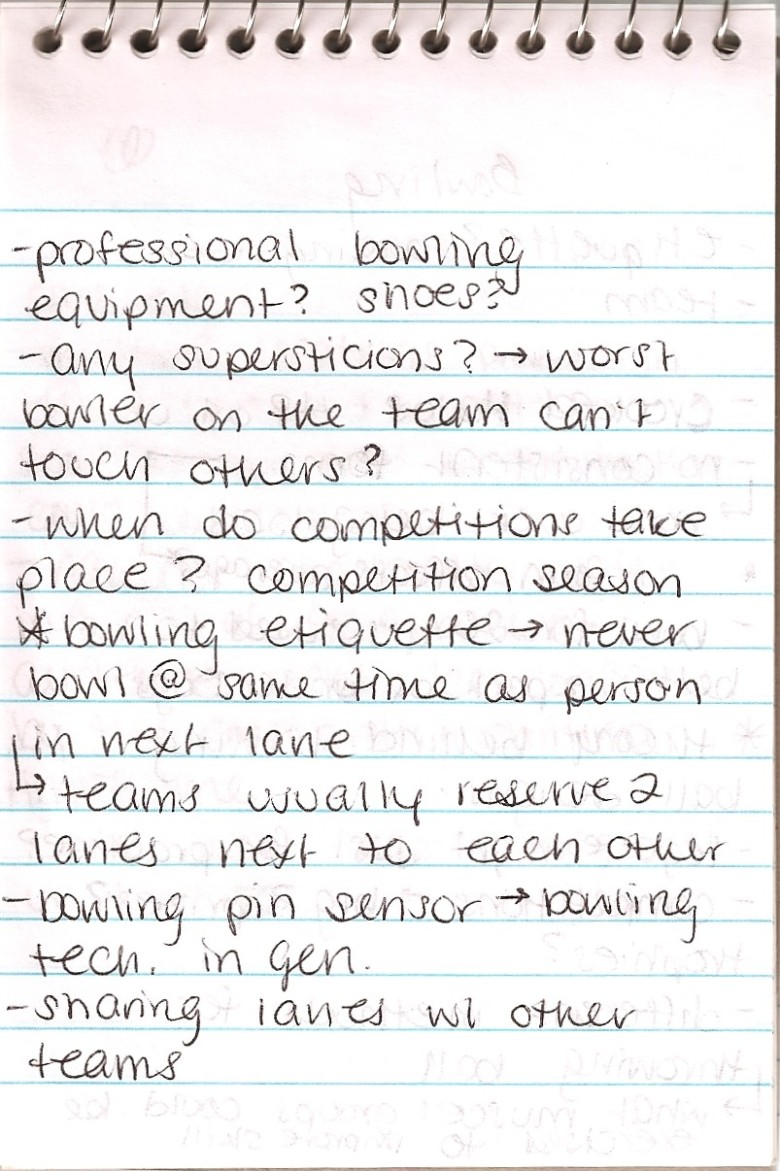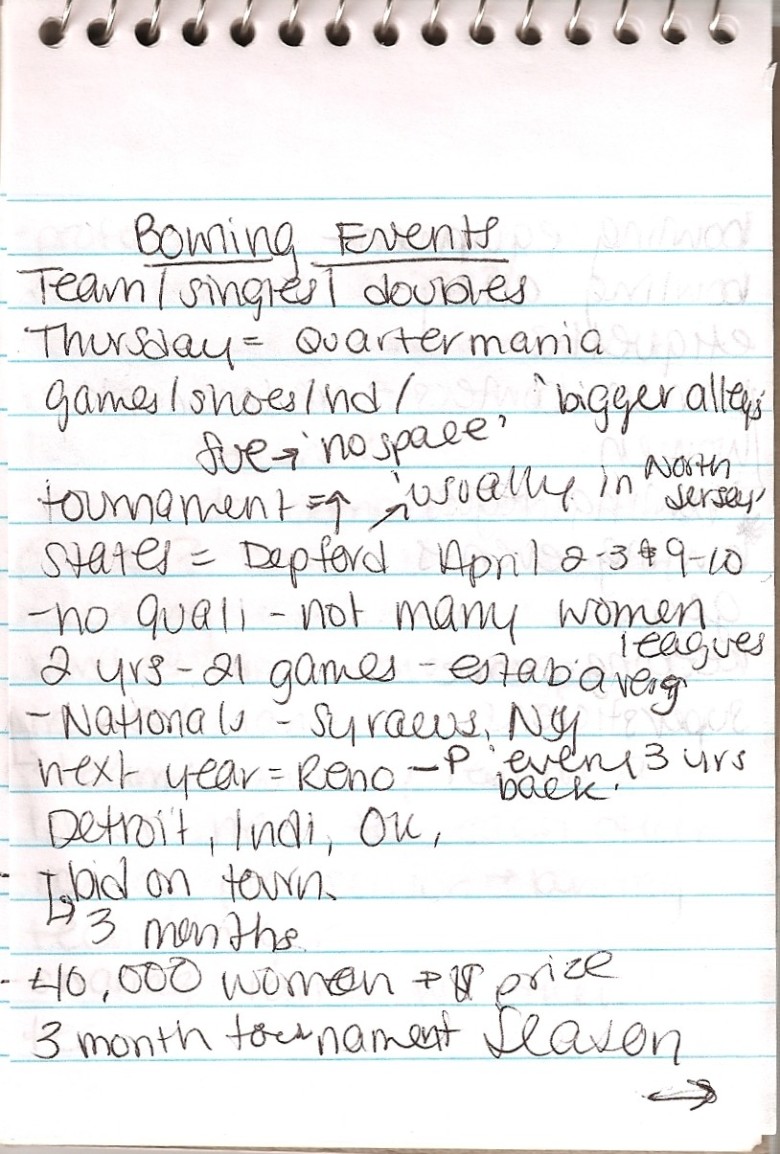According to Writing Ethnographic Fieldnotes by Robert M. Emerson, Rachel I. Fretz, and Linda L. Shaw, “ethnographers often want to write [or transcribe their fieldnotes from their jottings] because they realize that writing is a way of seeing, that a lived experience is not only preserved but also is illuminated through writing about it” (p. 63). Thursday night’s Core 2 class set out to do just that.
Rather than meeting in the classroom, my classmates and I trekked out to the local bowling alley, Glassboro Bowl and Recreation Center, to conduct some field research. Dr. Wolff split us into groups of four, and we were set loose to try to uncover as much information about bowling as we possibly could. My group made our way over to the side of the alley where the women’s leagues were bowling and began to observe. After about 20 minutes of jotting down our thoughts, we each chose a topic we would explore on our own. I chose bowling events, tournaments in particular. The following are my field jottings:








Transcription:
League night at the bowling alley was a new experience for me. As I enter the alley, a blast of sounds hit my ears. BOOM-THWACK-PRRUMM. Over and over again, alley after alley. After I grow accustom to the noise, I next noticed the stares. In a room full of a variety of characters, my classmates and I clearly stick out as the misfits. I’ve only been bowling a handful of times, and I’ve never seen bowling teams practicing. As a result of my curiosity, I decided to try to discover as much as I could about the bowling events these teams would participate in.
I assumed that league night was reserved for people who were serious about bowling (I didn’t understand that there was a difference between being part of a league and being a professional bowler), but the women I was about to converse with viewed league night as “a chance to get away from our kids and husbands for a night,” one member of the Looney Tunes admits while chuckling with her teammates.
Some of the ladies do take bowling very seriously, but the Looney Tunes enjoy being part of the league because it provides an escape from their daily lives and routines. When I asked if they looked at league night as a chance to improve their skills for tournaments, Pam shook her head and laughed, “ Oh no, we look at it more as a chance to hang out, drink, and have a good time.”
Sue, who was the member most knowledgeable about tournament season, which takes place between February and May, relayed to me that this your the 66th Annual States Championship Tournament are being held in Deptford this year. “It’s nice,” she continued, “because States are usually held in North Jersey.” And when I questioned as to why that happens, she replied “Well, there are bigger alleys up there. It’s not really common down here for women to be interested in bowling, so there isn’t as much space. There’s a lot of women you have to fit in one alley all at the same time, and we just don’t have the space.”
With Nationals just around the corner, most of the leagues are looking forward to the trip. “It’s more like a vacation than a tournament,” Beth said as she took a gulp from her soda before retrieving her ball from the ball return, “we’re not really concerned about winning. We’re just going to have fun.”
Pat adds, “We’re really looking forward to next year’s tournament in Reno. Every three years we go back there, and its always such a good time. They used to have a banquet at the end of the tournament, but now they give out cash prizes instead. Most women would prefer to leave with some money, but I do miss the banquets. They were always a good time. It was a chance to get to know some of the other women in the league. I met a lady who was 101-years-old, and she was having a blast. She had a better score than some of the younger league members!”
The tournament locations are decided by bid. Similar to the Olympics, cities cast their bid to host the competition, and whichever city desires to play host is award the opportunity. There are no qualifications or specifications that need to be met in order to compete in the tournaments. All a bowler needs is to have played for at least 21 games over the two years preceding the match to establish an average, and of course, be part of a sanction league, which members pay dues and fees to go into the pot of cash prizes awarded at the competitions.
Most of the women in the league average a score between 115 and 200. While participating in tournaments, the women are divided, so they can compete against women with scores similar to theirs. Beth chimes in, “People who average below 140 have a chance to win too. At States, at least six people will win cash for their highest score rather than just the highest scores for the tournament. It’s really a fun league that tries to make sure everyone has fun.”
This coming weekend, the Looney Tunes will compete in the 11th Annual Queens Tournament in Woodstown. With one hundred dollars on the line for first prize, some bowlers may feel pressured to bowl their best. Not the Looney Tunes. Pat shrugs her shoulders and says, “It’s just another afternoon with the ladies.”
An additional part of the night’s assignment was to follow another student, whom Dr. Wolff assigned to us, and observe his or her strategy in the field. I was assigned Meghan. At first, she seemed to just be wondering around, taking in her surroundings and chatting with some of our classmates, but after that, she went into the Pro Zone and was busy chatting with Jason, the high school boy who worked the counter back there. Since I didn’t even know that section of the alley existed, I’m thankful to Meghan for inadvertently pointing it out to me.
Overall, the night was a great chance to practice observing and taking fieldnotes, which is a lot more difficult than I thought it was going to be. And now, it’s time to take my skills out on the road to find some ghosts!







